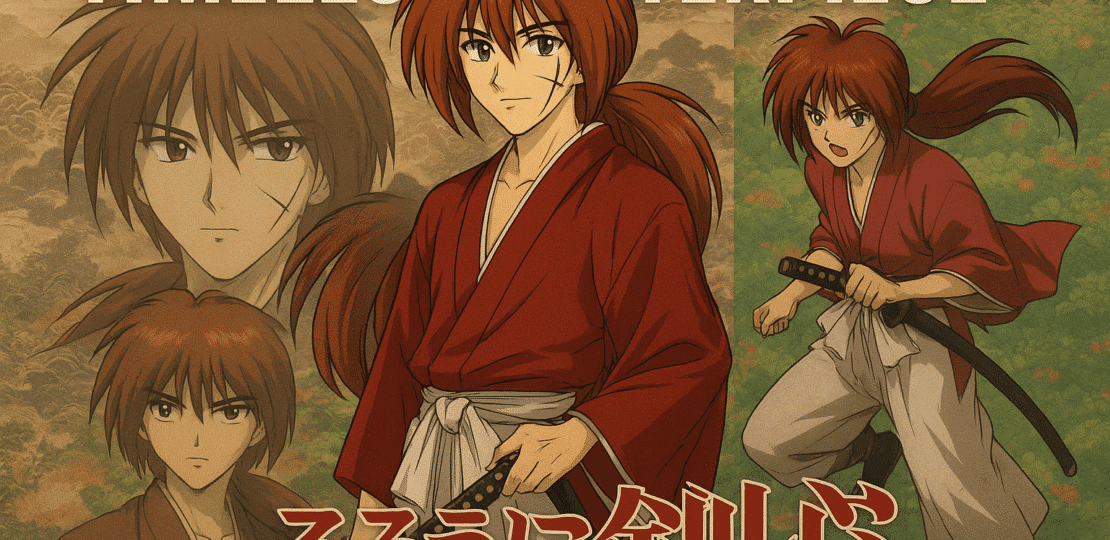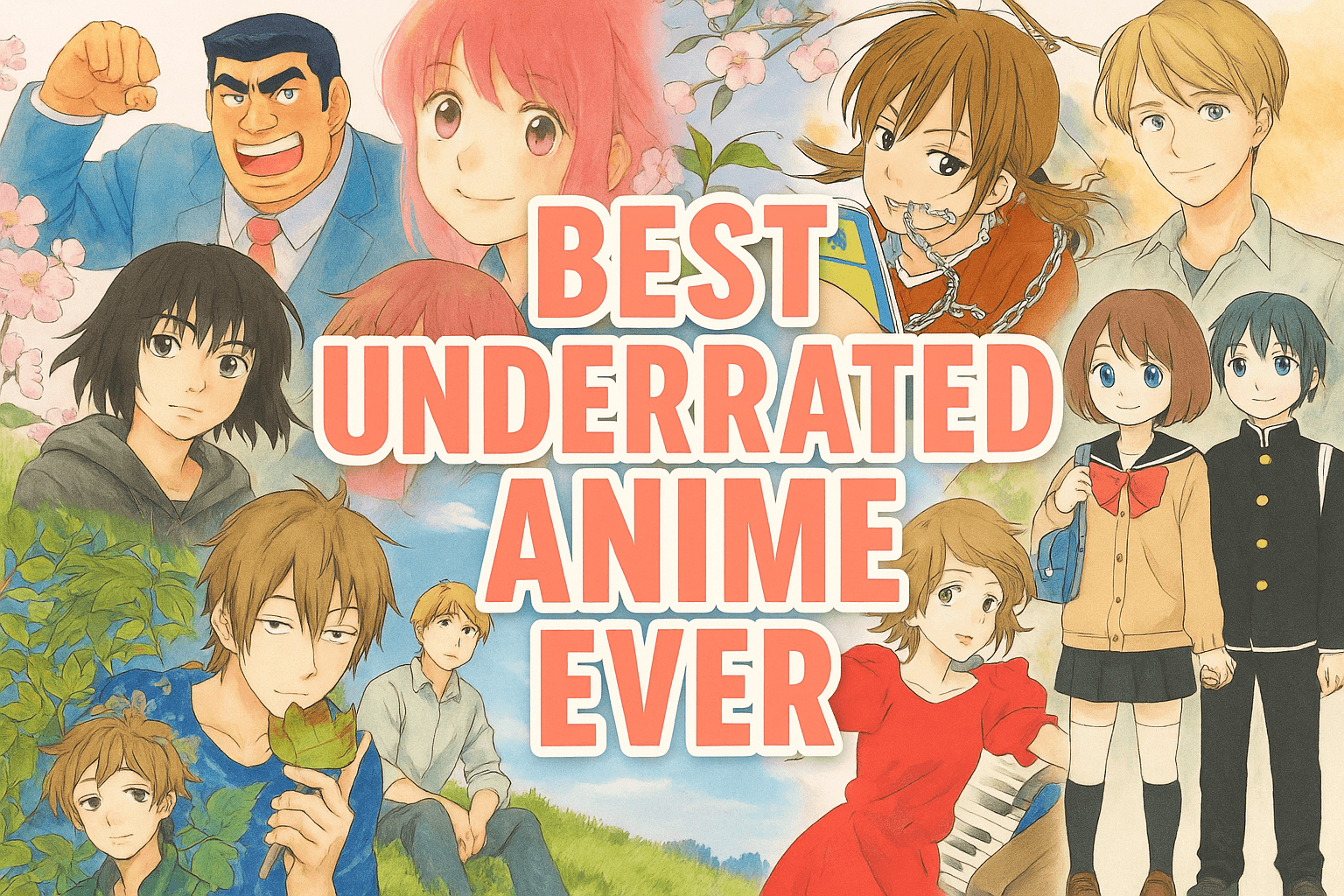Rurouni Kenshin: 6 Epic Reasons It’s a Timeless Masterpiece of Redemption and Swordplay
August 18, 2025 | by Haku

Introduction (Rurouni Kenshin)
Rurouni Kenshin, also known as Samurai X in some international releases, is one of the most influential and beloved anime series of all time. Created by Nobuhiro Watsuki, the manga ran in Weekly Shōnen Jump (1994–1999), spanning 28 volumes and selling over 72 million copies worldwide.
Set in the early Meiji era (1868), a time of rapid modernization after the samurai-dominated Edo period, the story follows Himura Kenshin, a former legendary assassin once feared as the “Hitokiri Battōsai” (Manslayer Battōsai). After the Bakumatsu wars that ushered in the Meiji Restoration, Kenshin vows never to kill again. Instead, he wanders as a “rurouni” (a term blending rurō for wanderer and nin for person), carrying a reverse-bladed sword (sakabatō) that symbolizes his pledge to protect the innocent without taking lives.
The series blends high-stakes action, historical drama, romance, and profound themes of atonement, making it a cornerstone of shōnen anime. Its 1996-1998 anime adaptation, directed by Kazuhiro Furuhashi and produced by Studio Gallop and Studio Deen, ran for 95 episodes and introduced the story to a global audience. A faithful 2023 remake by Liden Films has reignited interest, with its second season, “Kyoto Disturbance,” airing from October 2024 to March 2025. Live-action films (2012-2021) starring Takeru Satoh as Kenshin are widely regarded as the best anime-to-live-action adaptations ever, praised for their choreography and fidelity to the source.
History and Creation
Nobuhiro Watsuki, inspired by his kendo training and fascination with Japan’s Bakumatsu period (1853-1867), debuted Rurouni Kenshin after two one-shot prototypes in 1992 and 1993. The first one-shot featured Kenshin stopping a crime lord at a dojo, while the second involved a wealthy girl named Raikōji Chizuru. Watsuki drew from real historical figures like Kawakami Gensai (a basis for Kenshin) and the Shinsengumi police force, weaving fiction with facts to educate viewers on Japan’s transition from feudalism to modernity. He aimed for a serious shōnen tone, contrasting with lighter contemporaries, and extended the series due to its popularity—the Kyoto arc alone lasted longer than planned.
The manga concluded in 1999, but spin-offs followed: Rurouni Kenshin: Restoration (2012-2013), Master of Flame (2014), and the ongoing Hokkaido Arc (started 2017). Viz Media licensed it for English release, starting in 2003, with omnibus editions later.
Plot and Characters
The narrative unfolds in 1878 Tokyo, where Kenshin saves Kamiya Kaoru, a young kendo instructor, from a impostor using his infamous name. He stays at her dojo, forming a found family with street fighter Sagara Sanosuke, orphan Myōjin Yahiko, doctor Takani Megumi, and others. Kenshin’s past haunts him through antagonists like Shishio Makoto, a burned revolutionary plotting to overthrow the government, and Yukishiro Enishi, seeking revenge for his sister’s death.
Key characters include:
- Himura Kenshin: A soft-spoken, polite wanderer hiding a deadly past. His internal conflict drives the series.
- Kamiya Kaoru: Kenshin’s love interest, embodying hope and normalcy.
- Sagara Sanosuke: A hot-headed ally with a giant zanbatō sword.
- Myōjin Yahiko: A young student who inherits Kenshin’s sword.
- Villains like Saitō Hajime (a stoic rival) and Shinomori Aoshi add depth.
The story arcs—Tokyo, Kyoto, and Jinchū—build to an emotional climax, ending with Kenshin’s marriage to Kaoru and their son, Kenji.
Adaptations
The original anime (1996-1998) is iconic for its animation, soundtrack, and voice acting (Mayo Suzukaze as Kenshin). OVAs like Trust & Betrayal (1999) explore Kenshin’s origins with mature themes, often hailed as peak anime. The 2023 remake offers updated visuals and fidelity to the manga.
Live-action films (five total, directed by Keishi Ōtomo) grossed millions, with The Final (2021) focusing on Enishi’s arc. Video games, novels, and musicals expand the universe.
Themes and Impact
Rurouni Kenshin delves into redemption, the cycle of violence, and societal change. Kenshin’s vow reflects Japan’s shift from war to peace, with historical accuracy educating on events like the Satsuma Rebellion. It influenced creators like Masashi Kishimoto (Naruto) and Hideaki Sorachi (Gintama), popularizing historical shōnen.
Why It’s One of the Greatest Animes
Rurouni Kenshin excels in storytelling, character development, and action choreography. Its blend of humor, drama, and philosophy sets it apart—Kenshin’s atonement arc is profound, inspiring fans on personal growth. High rankings in polls (e.g., Da Vinci magazine’s Shōnen Jump greatest, Animate Times’ 2021 vote) affirm its status. The soundtrack, openings like “Sobakasu,” and themes of anti-violence in a violent world resonate. Nostalgia plays a role, but its rarity in samurai-era settings and emotional depth make it timeless. Reviews call it “the ultimate samurai anime,” with OVAs topping all-time lists. Its live-actions prove the story’s adaptability, outshining adaptations like Death Note.
Controversies
The series’ legacy is marred by Watsuki’s 2017 arrest for possessing child pornography (over 100 DVDs of girls under 15). He was fined ¥200,000 (about $1,800) without jail time, sparking outrage. Serialization paused briefly, but he resumed, dividing fans—some boycott, others separate art from artist. This has tainted discussions, with journalists avoiding coverage.
Conclusion
Despite controversies, Rurouni Kenshin’s gripping tale of a reformed killer in a transforming Japan cements its place among anime greats. It offers action, heart, and history, inspiring generations. With ongoing adaptations, its influence endures.
RELATED POSTS
View all


